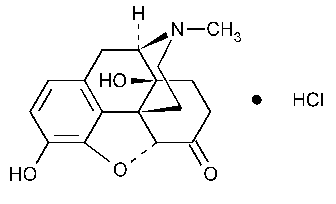Oxymorphone Hydrochloride
Morphinan-6-one,4,5-epoxy-3,14-dihydroxy-17-methyl-,hydrochloride,(5a)-.
4,5a-Epoxy-3,14-dihydroxy-17-methylmorphinan-6-one hydrochloride [357-07-3].
»Oxymorphone Hydrochloride contains not less than 97.0percent and not more than 102.0percent of C17H19NO4·HCl,calculated on the dried basis.
Packaging and storage—
Preserve in tight,light-resistant containers.Store at 25 ,excursions permitted between 15
,excursions permitted between 15 and 30
and 30 .
.
Identification—
A:
Dissolve about 250mg in 25mLof water,and render the solution alkaline with a saturated solution of sodium bicarbonate.Extract the liberated oxymorphone with two 15-mLportions of chloroform.Reserve the chloroform extracts,combined in a second separator,for Identificationtest B:the aqueous phase,acidified with 2Nnitric acid,responds to the tests for Chloride á191ñ.
B:
Wash the combined chloroform extracts from Identificationtest Awith 5mLof water,and filter.Evaporate the chloroform solution on a steam bath nearly to dryness,then add a few mLof ether,and continue the evaporation with stirring until the solvent is removed:the IRabsorption spectrum of a 1in 50solution in alcohol-free chloroform of the oxymorphone so obtained,determined in a 0.5-mm cell,exhibits maxima only at the same wavelengths as that of a similar solution of USP Oxymorphone RS.
C:
The UVabsorption spectrum of a 1in 6500solution in 0.1Nhydrochloric acid exhibits maxima and minima at the same wavelengths as that of a solution of USP Oxymorphone RS,prepared by dissolving about 20mg of the Reference Standard in 10mLof 1Nhydrochloric acid and diluting with water to 100.0mL.The ratio A281/A264is 1.75±0.2.
D:
Dissolve 10mg in 1mLof water,and add a few drops of ferric chloride TS:a blue color is produced immediately.
Acidity—
Dissolve 300mg in 10mLof water,add 1drop of methyl red TS,and titrate with 0.020Nsodium hydroxide:not more than 0.30mLis required to produce a yellow color.
Loss on drying á731ñ—
Dry it at 105 for 18hours:it loses not more than 8.0%of its weight.
for 18hours:it loses not more than 8.0%of its weight.
Residue on ignition á281ñ:
not more than 0.3%.
Limit of nonphenolic substances—
Dissolve 1g in 15mLof water,add 5mLof sodium hydroxide solution (2in 25),and extract with three 10-mLportions of chloroform.Filter the combined extracts through a small chloroform-moistened filter paper,and wash the filtrate with 5mLof water.Filter the chloroform layer through chloroform-moistened filter paper into a tared,50-mLbeaker,and evaporate on a steam bath with the aid of a gentle current of filtered air to dryness.Dry the beaker and residue at 105 for 1hour,and weigh:the residue so obtained does not exceed 15mg.
for 1hour,and weigh:the residue so obtained does not exceed 15mg.
Ordinary impurities á466ñ—
Test solution:
methanol.
Standard solution:
methanol.
Eluant:
a mixture of dehydrated alcohol,cyclohexane,and ammonium hydroxide (10:5:1).
Visualization:
1.
Chloride content—
Dissolve about 300mg,accurately weighed,in 50mLof methanol in a glass-stoppered flask,add 5mLof glacial acetic acid and 3drops of eosin Y TS,and titrate with 0.1Nsilver nitrate VS.Each mLof 0.1Nsilver nitrate is equivalent to 3.545mg of Cl:the content is between 10.2%and 10.8%,calculated on the dried basis.
Assay—
Transfer about 700mg of Oxymorphone Hydrochloride,accurately weighed,to a glass-stoppered flask containing 50mLof glacial acetic acid and 10mLof mercuric acetate TS.Add 3mLof acetic anhydride and 1drop of methyl violet TS,and titrate with 0.1Nperchloric acid VSto a clear blue color.Perform a blank determination,and make any necessary correction.Each mLof 0.1Nperchloric acid is equivalent to 33.78mg of C17H19NO4·HCl.
Auxiliary Information—
Staff Liaison:Daniel K.Bempong,Ph.D.,Scientist
Expert Committee:(PA2)Pharmaceutical Analysis 2
USP28–NF23Page 1446
Pharmacopeial Forum:Volume No.29(6)Page 1946
Phone Number:1-301-816-8143
